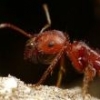A while back I purchased a founding colony with one larvae and two queens. Unfortunately, the queens ate the larvae, but today I saw what looks like eggs or another larvae. I assume that the one of the queens have laid an egg, and not larvae because I did not notice the them before. I was just really happy to see that the colony was not going to fall apart, but I wondered how long does it take an egg to hatch into a larvae the eclose to a worker.
Do any of you guys know the time it may take for an egg to go to to worker?















